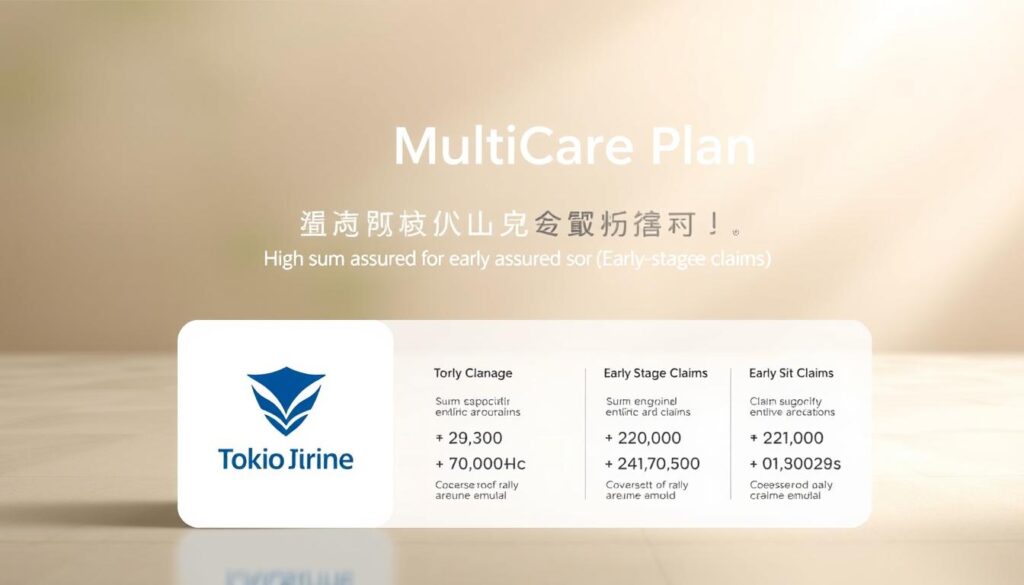Health challenges can arise unexpectedly, making financial preparedness essential. In Singapore, coverage options for serious medical conditions have evolved significantly in 2025. Modern policies now offer features like multi-pay benefits and specialized support for chronic conditions.
Leading insurers such as Singlife, Tokio Marine, and AIA provide flexible plans tailored to different needs. These options often include partial payouts for early-stage diagnoses and premium refunds. The right choice depends on factors like coverage scope, claim flexibility, and additional wellness benefits.
With medical expenses rising, securing appropriate protection helps safeguard savings. This guide compares five reputable providers, highlighting their unique advantages. We’ll examine payout structures, mental health inclusions, and family-oriented features to simplify your decision-making.
Key Takeaways
- Multi-pay options provide ongoing financial support during treatment
- Early-stage condition coverage differs from traditional lump-sum policies
- Premium flexibility and refund options add value to modern plans
- Specialized riders address diabetes management and mental wellness
- Juvenile protections help secure children’s future health needs
Why Multipay Critical Illness Coverage Matters in Singapore
Income disruption during treatment often hits harder than the illness itself. With medical inflation rising 10% annually, even robust savings can deplete quickly. Modern critical illness plans now address this gap with staggered payouts, covering everything from early-stage diagnoses to recovery phases.
The rising cost of healthcare and income protection
Cancer treatment costs in Singapore surged 43% since 2020, with six months of income replacement averaging S$150,000. CPF MediSave often falls short, covering only basic hospital bills.
Multipay plans bridge this gap. For example, Aviva’s policy allows claims at any progression stage—no waiting periods. This flexibility helps maintain cash flow when patients need it most.
How multipay plans differ from traditional coverage
Traditional policies offer a single lump sum, leaving gaps for recurring conditions. In contrast, HSBC’s multipay option provides up to 600% coverage across multiple claims.
Tokio Marine takes it further, covering 98 illness stages versus older plans’ 37. This matters because, as studies show, 70–90% of Stage 3B patients face relapses within a decade.
Premiums reflect this advantage: S$4,500/year at age 35 versus S$11,470 at 50. Yet, multipay prevents policy lapse after the first claim—a safety net traditional options lack.
Top-Rated Critical Illness Plans in Singapore
Understanding payout structures helps tailor coverage to individual needs. Leading providers offer distinct advantages, from multi-claim options to juvenile protections. Here’s how five top insurers compare across 12 key metrics.

Payout potential and coverage scope
Singlife sets the benchmark with a 900% total sum assured, far exceeding competitors. HSBC follows at 600%, while Manulife caps at 500%. Early-stage payouts vary widely—HSBC offers S$350k versus Manulife’s S$250k.
AIA’s unique perk? A 100% refund of all premiums paid if the policyholder reaches age 85. Tokio Marine stands out with no waiting period, unlike Manulife’s 12-month delay.
Breaking down stage definitions
Plans categorize conditions into three stages: early, intermediate, and advanced. Early-stage coverage often includes minor surgeries, while advanced stages trigger full payouts. Tokio Marine covers 98 illness phases, the broadest in the market.
Cost and demographic factors
A 35-year-old male pays between S$2,142 and S$4,624 annually for S$100k coverage. Women save up to 15% due to lower risk profiles. Juvenile plans cover 11–16 conditions, ideal for family protection.
| Provider | Max Payout | Early-Stage Cover | Premium (35yo) |
|---|---|---|---|
| Singlife | 900% | S$300k | S$4,624 |
| HSBC | 600% | S$350k | S$3,891 |
| Tokio Marine | 500% | S$320k | S$3,450 |
Singlife Multipay Critical Illness: Flexible Coverage Up to 900%
Modern protection plans now offer unprecedented flexibility for evolving medical needs. Singlife’s multipay option stands out with a payout 900% of the sum assured, providing layered support across diagnosis stages. Unlike single-claim policies, it covers benign tumors and offers S$25k for special conditions like borderline malignant tumour cases.
Advantages of Choosing Singlife
The plan’s 100 sum assured structure ensures comprehensive protection. Advanced-stage claims trigger 300% payouts, while early-stage diagnoses (like carcinoma-in-situ) qualify for partial benefits. Premium waivers activate automatically during claims—no extra riders needed.
ICU coverage adds another layer, with S$5k daily for 30 days. For a 40-year-old female, annual premiums average S$5,737, competitive given the extended term option to age 99.
Considerations to Note
Complexity arises from six claim types across three benefit groups. Early and intermediate claims require a 1-year wait between filings. The S$250k cap per condition may limit high-need scenarios compared to rivals.
Standout Feature: Progressive Illness Coverage
Singlife eliminates waiting periods for worsening conditions—a rarity in the market. The Advance Care Option lets policyholders access 50% of the sum assured early, though this reduces future payouts. As one advisor notes:
“This flexibility is invaluable for families managing long-term treatment costs.”
Tokio Marine MultiCare Plan: High Sum Assured for Early-Stage Claims
Financial safety nets need to adapt as medical diagnostics improve. Tokio Marine’s MultiCare plan leads with a S$350k early-stage payout—the highest in Singapore. This sum assured structure covers 98 illness phases, from minor procedures to advanced conditions like heart attack or stroke.

Why This Plan Stands Out
The 700% total coverage works through three benefit layers. Early detections qualify for partial payouts, while advanced stages trigger 300% of the sum assured. Unique inclusions address osteoporosis and diabetic complications—rare in standard plans.
Family protection extends to 10 juvenile conditions. Premiums run 15% above market average, but the extensive coverage justifies the cost. Gender-based pricing shows a 4-7% difference favoring female applicants.
Limitations to Consider
Policy terms offer limited flexibility with only three age options (70/75/85). Cancer recurrences require a 24-month waiting period—longer than some competitors. The plan lacks automatic premium waivers, requiring a separate rider.
Real-World Claim Scenario
Consider a policyholder diagnosed with Stage 2B lymphoma. They’d receive:
- S$175k initial payout (50% of early-stage maximum)
- S$525k upon progression to Stage 4 (300% benefit)
- Continued coverage for other conditions
As one financial advisor notes:
“The layered payout system provides sustained support during treatment transitions.”
AIA Beyond Critical Cover: Mental Health and Child Illness Inclusion
Comprehensive protection now extends beyond physical ailments to include mental wellness. AIA’s plan stands out with coverage for five psychological conditions, alongside robust safeguards for children. This dual focus addresses gaps in traditional plans.

Advantages of AIA’s Approach
The plan offers S$150k for childhood illnesses like leukemia or congenital conditions. Mental health support provides 20% of the sum assured (up to S$50k) for diagnoses such as major depression.
Notably, policyholders receive a 100% premium refund if they reach age 85. For a 50-year-old woman paying S$9,643 annually, this could mean S$288k returned tax-free.
Limitations to Weigh
Early-stage coverage ends at age 75, earlier than competitors. Only two claims are allowed lifetime, and riders aren’t refunded. Special condition protections were reduced from 11 to five, excluding rarer diseases.
Unique Perk: Age 85 Refund
This feature effectively lowers the net cost of long-term protection. For example:
- Total premiums paid over 35 years: S$337k
- Refund amount: S$337k (no interest)
As one advisor explains:
“The refund transforms the plan into a hybrid safety net—protection with a savings component.”
HSBC Super CritiCare: Affordable Coverage with Diabetes Support
Affordable protection plans now include specialized support for chronic conditions. HSBC’s Super CritiCare stands out with a S$3M maximum sum assured and tailored benefits for diabetes management. This plan balances cost and coverage, making it a practical choice for budget-conscious families.

Pros of HSBC Super CritiCare
Premiums are 35% lower than market averages, ideal for long-term budgeting. Flexible terms let you renew every 5–30 years, adapting to changing needs.
The early-stage payout reaches S$350k, covering carcinomas across eight body sites. HSBC’s Very Good Health Initiative rewards policyholders with discounts for healthy habits.
Cons to Consider
Coverage terminates at age 75, earlier than some competitors. A 24-month wait applies to cancer recurrences, and unrelated claims require a 1-year gap.
Added Value: Complimentary Diabetic Care Program
Policyholders access a S$2,500/year program with screenings and specialist consultations. Success metrics show a 40% improvement in blood sugar management for participants.
As one user shared:
“The diabetic support made managing my condition easier without extra costs.”
Manulife CI FlexiCare: Reset Benefits for Recurring Conditions
Recurring health conditions require adaptable financial solutions. Manulife’s plan addresses this with four coverage resets, protecting against multiple diagnoses. The policy covers 126 conditions across different severity stages.
Advantages of Manulife CI FlexiCare
The 200% advanced-stage sum assured provides substantial support during serious treatments. Children receive free S$10k protection for juvenile conditions like Kawasaki disease.
Recovery Care Plus offers S$200/day for 100 days post-hospitalization. This helps bridge income gaps during convalescence periods.
Limitations to Consider
The plan covers 10 special conditions versus competitors’ 16. Dengue fever protection has specific diagnostic requirements.
Male premiums show notable age-based increases:
- Age 35: S$2,850/year
- Age 45: S$4,120/year
- Age 55: S$6,900/year
Standout Feature: Cover Me Again Rider
This add-on enables multiple claims for the same illness after 12-month waiting periods. Each reset restores the original sum assured amount.
Consider this claim scenario:
- Initial lymphoma diagnosis: S$100k payout
- Reset activates after 12 months
- Recurrence treatment: Another S$100k available
“The reset feature provides peace of mind for chronic condition management,” notes a Manulife advisor.
Critical Illness Plan Comparison: Premiums and Payouts
Financial planning for medical contingencies requires comparing costs and benefits across available options. Key factors like age, gender, and coverage terms create significant price variations. This analysis breaks down pricing structures and maximum protections.
Cost differences by demographic
Women typically pay 22-35% lower premiums than men for identical coverage. Insurers cite lower risks for conditions like heart disease as the primary reason.
A 35-year-old male’s annual costs range from S$2,142 to S$4,624 for S$100k coverage. By age 50, this jumps to S$6,200-S$11,470. Smokers face 15-20% surcharges across all providers.
| Provider | 35yo Male | 35yo Female | Max Payout |
|---|---|---|---|
| Singlife | S$4,624 | S$3,248 | S$900k |
| HSBC | S$3,891 | S$2,715 | S$3M* |
| Tokio Marine | S$3,450 | S$2,587 | S$700k |
*Highest in market for diabetes-related cancer claims
Total protection value analysis
Maximum payout potentials vary dramatically:
- HSBC leads with S$3M (diabetes rider required)
- Singlife offers 900% sum assured but caps at S$250k/condition
- Manulife’s reset feature provides recurring claim opportunities
Break-even ages for refund plans:
- AIA: 85 years (full premium return)
- Tokio Marine: 75 years (50% refund)
As one financial planner notes:
“The S$100k coverage metric reveals true value—compare what each dollar buys in protection.”
How to Choose the Best Critical Illness Plan for Your Needs
Selecting the right financial safety net requires careful evaluation of personal needs and existing protections. With 63% of Singaporeans underinsured for serious health conditions (LIA 2024), identifying gaps ensures comprehensive cover.
Assessing Your Current Protections
Start with a gap analysis checklist:
- Family history: Note hereditary conditions like diabetes or heart disease.
- Income replacement: Aim for 3–5 years of earnings in coverage.
- Policy overlaps: Avoid duplicating hospital plan benefits.
Digital tools from insurers like AIA or Singlife simplify this audit. For example, HSBC’s calculator factors in age and lifestyle risks.
Aligning Plans with Life Stages
Priorities shift across ages:
- Singles: Focus on early-stage critical illness payouts and premium affordability.
- Parents: Add juvenile protections and multi-claim options.
Chronic conditions demand specialized riders. Tokio Marine’s diabetic care program, for instance, complements standard plans.
“Review protections every 5 years—life changes faster than policy terms.”
Conclusion: Your Next Steps for Financial Protection
Choosing the right financial safety net requires understanding key differences between plans. Multi-pay options provide ongoing support, unlike single-payout policies. They help manage treatment costs over time.
Start by assessing your needs. Consider family history and income replacement goals. Free advisory services can guide you through this process.
Compare quotes from different providers. Look at coverage details like mental health benefits and diabetic care programs. Premium calculators help estimate costs.
Act soon to lock in lower rates before age-related increases. Modern plans evolve yearly—2025 updates may bring better terms. Your health deserves this proactive step.


